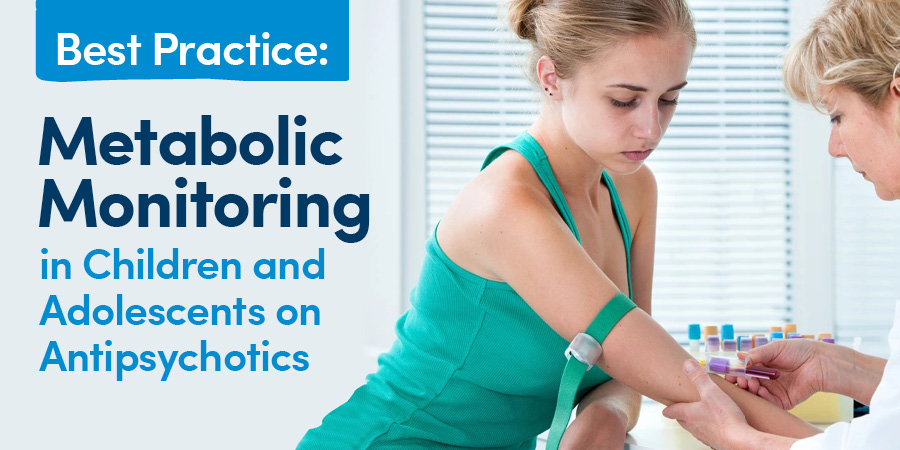

Antipsychotic medications offer the potential for effective treatment of psychiatric disorders in children and adolescents; however, these drugs can also increase the risk for developing serious health concerns, including metabolic health complications. While newer medications (atypical antipsychotics/second-generation antipsychotics) have fewer side effects — especially less extrapyramidal symptoms than first-generation antipsychotics — there are still inherent risks that must be weighed against the benefits of taking these medications.
 Expanded Use
Expanded UseThe Food and Drug Administration initially approved the use of antipsychotics for the treatment of childhood schizophrenia, bipolar disorder, and psychosis. More recently, the agency approved the use of antipsychotics for the “treatment of severe conduct problems that are resistant to other types of treatment,” including behavioral symptoms associated with Tourette’s syndrome and autistic disorders.1
While antipsychotics are deemed appropriate for a narrow range of behavioral health diagnoses, research has shown that these medications are prescribed more frequently for off-label use, especially for resistant behaviors associated with attention deficit hyperactivity disorder (ADHD).2
 Antipsychotic medications often increase the risk of weight gain, hyperlipidemia, and diabetes in younger patients. As a result, the American Academy of Child and Adolescent Psychiatry (AACAP) guidelines recommend that children and adolescents — who are taking antipsychotic medications — should have baseline levels for blood glucose and cholesterol levels, as well as body mass index (BMI) percentile documentation.3 Routine monitoring must be completed after baseline levels have been obtained to ensure that these medications are providing beneficial results without negative health implications.
Antipsychotic medications often increase the risk of weight gain, hyperlipidemia, and diabetes in younger patients. As a result, the American Academy of Child and Adolescent Psychiatry (AACAP) guidelines recommend that children and adolescents — who are taking antipsychotic medications — should have baseline levels for blood glucose and cholesterol levels, as well as body mass index (BMI) percentile documentation.3 Routine monitoring must be completed after baseline levels have been obtained to ensure that these medications are providing beneficial results without negative health implications.
However, studies have shown that metabolic monitoring rates associated with second-generation antipsychotics are well below optimal levels, especially for lipid monitoring.4 Early interventions can decrease the possibility of long-term sequelae associated with this class of drugs, especially cardiac disease, type 2 diabetes, and obesity.
Highmark will be periodically reviewing metabolic monitoring for those pediatric/adolescent members taking antipsychotic medications, as per the National Committee for Quality Assurance (NCQA) Healthcare Effectiveness Data and Information Set (HEDIS)® guidelines.
References
1. Harrison, J.N., Cluxton-Keller, F., & Gross, D. (2012). Antipsychotic medication prescribing trends in children and adolescents. Journal of Pediatric Health Care, 26(2), 139–145. https://doi.org/10.1016/j.pedhc.2011.10.009 
2. Sohn, M., Moga, D.C., Blumenschein, K., & Talbert, J. (2016). National trends in off-label use of atypical antipsychotics in children and adolescents in the United States. Medicine, 95(23). https://doi.org/10.1097/md.0000000000003784 
3. American Academy of Child and Adolescent Psychiatry (AACAP)(n.d.) Practice parameter for the use of atypical antipsychotic medications in children and adolescents. https://www.aacap.org/App_Themes/AACAP/docs/practice_parameters/Atypical_Antipsychotic_Medications_Web.pdf 
4. Hayden, J.D., Horter, L., Parsons III, T., Ruble, M., Townsend, S., Klein, C.C., Duran, R.P., Welge, J.A., Crystal, S., Patel, N.C., Correll, C.U. & DelBello, M.P. (2020) Metabolic Monitoring Rates of Youth Treated with Second-Generation Antipsychotics in UsualCare: Results of a Large US National Commercial Health Plan. Journal of Child and Adolescent Psychopharmacology 30(2). 119-122. http://doi.org/10.1089/cap.2019.0087 
Disclaimer
Highmark does not recommend particular treatments or healthcare services. This informational article is not intended to be a substitute for professional medical advice, diagnosis, or treatment. The member’s provider should determine the appropriate treatment and follow-up with his or her patient. This informational article is based upon a search of literature: there may be other recommendations or suggested practices that may be suitable in the care of patients. Coverage of services is subject to the terms of each member’s benefit plan. Additionally, state laws and regulations governing health insurance, health plans, and coverage may apply and will vary from state to state.
HEDIS® is a registered trademark of the National Committee for Quality Assurance (NCQA).